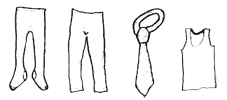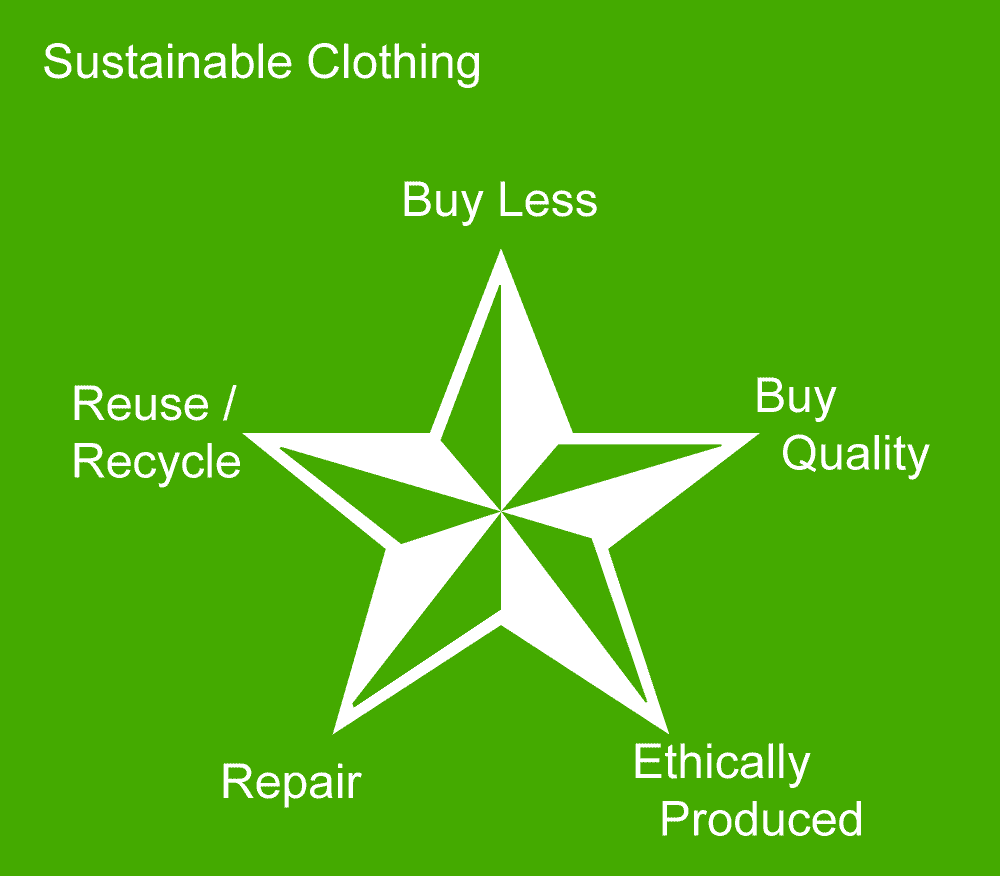 Sustainable
Clothing
Sustainable
Clothing
The clothing / fashion industry is the worlds second largest polluter after oil. How can we reduce the impact we have on our planet by our choices of the clothes we wear?
How you can help
1 - Buy fewer items of clothing in the first
place
- much
of the environmental impact of clothing is in the manufacture.
2 - Buy quality items that will last and you
will want to keep and keep wearing
- buying fewer items in the long run means less impact at
every stage.
3 - Buy clothing that has sustainability or ethical
credentials and avoid the cheapest "fast fashion"
- not so easy to do always but becoming easier, and #1 and
#2 above always work.
4 - Repair clothing when it needs it and continue
to use it
- prevents
a new item being made, saves you money and you get to still
wear your favourite clothes.
5 - When disposing of clothing, donate directly
to others, to a charity shop or clothing bank
- there is rarely any need to send unwanted clothing straight
to landfill, it can almost always be reused.
2nd Largest Polluter
The fashion industry is the second largest polluter
on the planet after oil

3 years
The average
lifespan of an item of clothing made today

Just 15% Reused / Recycled
85% of unwanted clothing is burnt or sent to landfill

Buy less, consume less - The most effective (and often least acceptable!) way
The most environmentally sustainable clothes are the ones you already own
It is surprisingly difficult to measure the environmental impact of manufacturing many clothing items which can have very complex supply chains. They may be made of more than one kind of fibre from different parts of the world, the production of each of which has its own impacts, these may then be brought together in another country with zips, buttons, thread etc. from somewhere else entirely, dyed and finished with coatings using imported chemicals, then packaged and sold locally or on the other side of the world. Each individual component may be produced in a variety of ways that vary in their impact from relatively clean to highly polluting.
The easiest way to reduce your own personal impact however is to simply buy less. Most people in developed countries could probably lose half of all of the clothes they own in drawers and on hangers and hardly notice the difference in practical terms. The environmental impacts are very much concentrated in the manufacturing process, so the fewer items made the less the impact.
Even if you have the least environmentally friendly clothes, buying less of them still reduces the impact even of these and in the absence of information about how the clothes were made you can still be certain you are doing something positive.
Emotional durability is usually the issue, people get tired of wearing something long before it is worn out, physical durability is generally not a problem.
Non-Organic Cotton
...uses 2.4% of all arable land and 25% of the world's
pesticides

Microfibres
Shed by all fibres when washed, natural materials
will decompose, synthetics may persist for centuries

$$$
The global fashion industry is worth $1.5 trillion
a year, it employs 250 million people

What causes the environmental impact?
1 - Production of fibres
This may involve intensively growing cotton using such large amounts of irrigation water that it disrupts the flow of rivers, and the addition of chemicals in the form of pesticides and herbicides. Organically grown cotton on the other hand with little or no irrigation has far less impact.
It may involve poor and even cruel practices in rearing sheep for wool and geese and ducks for their down, with additional effects such as overgrazing and soil degradation. It doesn't have to be like this though, it is perfectly possible to use sympathetic farming methods with animal welfare to the fore
It may involve the production of cheap synthetic fibres in highly wasteful, energy-intensive, air polluting processes making garments that shed large amounts of microfibres into the environment when washed and dried. Recycling and resistance to breakdown is an issue with synthetics, many of them will still be around in a couple of centuries or more. Resources can be saved and disposal avoided by using recycled fibres produced with care taken to minimize pollution and by donating or recycling them when the owner has no further need for them.
2 - Dyeing, washing and the application of finishes - to change the feel or properties of the finished garment.
This uses large amounts of water and generates large amounts of waste water. Depending on the chemicals used and how the water is disposed of it can have significant effects on the environment. At the worst, poisonous heavy metals and other chemicals are simply discharged into rivers, something that happens where there are minimal or lax controls or where corruption leads to a blind eye being turned.
Alternatively where there are good environmental controls and with manufacturers who care about the impact of their products, these processes can be much more benign.
Supply Chain
Garment manufacture has some highly complex supply chains,
monitoring these is a good way to ensure sustainability

Buy Quality, Keep Longer, Mend, Donate
Ownership and disposal are important
for sustainability

What can the Individual Do?
Doing something - anything to help
is better than doing nothing, be aware and inform others

3 - Waste and disposal
Microfibres - it is becoming more and more apparent that plastics of all kinds generate tiny particles that are collectively called microfibres. These can just about be seen by the naked eye though are more often than not overlooked. These have been building up around the planet in all places for years and have reached almost all parts of the world. How much of an impact they are having or may be having is largely unknown as awareness of their prevalence is relatively recent and research is in the early stages.
Laundering synthetic clothing and drying in tumble driers generates huge numbers of microfibres that find their way into water courses via sewage treatment plants and into the air.
Increasingly clothing has become disposable with some garments being bought to be worn on a single occasion and then discarded. Only 15% of all unwanted clothing is donated or recycled, the rest goes to landfill or is burnt.
Natural fibres will break down and rot eventually being fully recycled in the planets' carbon and nitrogen cycles, but synthetics will persist for very long periods, 200 or 400 years has been suggested though as they have not been around for so long, we don't really know. Often garments are made of a combination of materials with polycotton in particular being very common, fibre mixtures make it very difficult to recycle clothes.
Greenwash - Also known as "green sheen"
Unfortunately a not uncommon process whereby products or brands are portrayed as being more environmentally friendly than they actually are, by means such as exaggerating positives, not telling the whole truth, hiding the negatives, talking about vague "aims" and "commitments" for the future rather than what they are actually doing now.
The purpose of Greenwash is to improve sales by making minimal cost changes that are touted as being "Eco" or "Environmental".
Uneven laws in different countries about advertising and lax enforcement can make it very difficult for the average consumer to determine whether or not claims are true and even if they are, whether they have much or any actual positive effect.
How do I know what the least environmentally damaging clothing is?!
There is no easy answer. Oil based synthetics can be more environmentally friendly than natural materials depending on how they are produced, the environmental footprint of a simple t-shirt can vary widely depending on what it is made of, how the fibres were produced, how the material was dyed and finished etc.
1 - The only foolproof way to
know you are having less impact is to buy fewer items, mend
them when needed and don't discard them for something new
too soon.
2 - Wear more than once before washing, wash at a lower temperature and air dry outdoors.
3 - When you do discard them, pass
them on to friends, family or charity.
Sustainable clothing will involve one or more of the following to some degree
- A traceable and transparent supply chain.
To readily identify if there are any aspects of the manufacture
of a garment that are at odds with the sustainable ethos.
- Organically grown materials, such as cotton,
hemp, wool and bamboo use less polluting practices
that are good for the long term health of soils as well
as not putting all those chemicals into the environment.
- Using recycled materials, so reducing
the production of new fibres from raw materials, this is
particularly relevant with polyester which
while is still quite rarely recycled as a fabric, is increasingly
being made from plastic bottles.
- Natural materials. Fully biodegrade
so even if they do end up in landfill they will breakdown
into compounds that become part of the natural carbon and
nitrogen cycles rather than still being around in hundreds
of years.
- Avoiding azo dyes, which can cause
environmental damage and can be harmful to work with.
- Avoiding PFC's perfluorocarbons in
waterproof clothing or as stain and dirt resistant coatings.
These are harmful to organisms that take them up in the
environment and are particularly persistent, the main contamination
comes from the manufacturing process.
- Paying a fair wage to those who make the clothes and ensuring they have a safe working environment. The cheapest clothes are usually made in unsafe factories in developing countries with poor regulation of working conditions and disposal of waste. Garment manufacturers at the lower end of the fashion industry supply chains pay amongst the worlds lowest wages, about 85% of the workers are women.
Which garments are "sustainable" and by how much is a very complex question, not all items from a particular brand are equally sustainable, or there may be a sustainable range of a proportion of all items on sale. By virtue of not being the lowest price, quick-and-dirty fast fashion, sustainability doesn't come dirt cheap and while some brands are still very affordable, others are more premium. Almost by definition, sustainable practices result in quality rather than disposable products.

